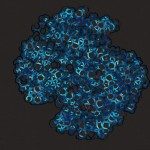Lien vers Pubmed [PMID] – 28427876
Lien DOI – 10.1016/j.jmb.2017.04.005
J Mol Biol 2017 Jun; 429(11): 1746-1765
Bacterial type 2 secretion systems (T2SS), type 4 pili, and archaeal flagella assemble fibres from initially membrane-embedded pseudopilin and pilin subunits. Fibre subunits are made as precursors with positively charged N-terminal anchors, whose cleavage via the prepilin peptidase, essential for pilin membrane extraction and assembly, is followed by N-methylation of the mature (pseudo)pilin N terminus. The conserved Glu residue at position 5 (E5) of mature (pseudo)pilins is essential for assembly. Unlike T4 pilins, where E5 residue substitutions also abolish N-methylation, the E5A variant of T2SS pseudopilin PulG remains N-methylated but is affected in interaction with the T2SS component PulM. Here, biochemical and functional analyses showed that the PulM interaction defect only partly accounts for the PulGE5A assembly defect. First, PulGT2A variant, equally defective in PulM interaction, remained partially functional. Furthermore, pseudopilus assembly defect of pulG(E5A) mutant was stronger than that of the pulM deletion mutant. To understand the dominant effect of E5A mutation, we used molecular dynamics simulations of PulGE5A, methylated PulGWT (MePulGWT), and MePulGE5A variant in a model membrane. These simulations pointed to a key role for an intramolecular interaction between the pseudopilin N-terminal amine and E5 to limit polar interactions with membrane phospholipids. N-methylation of the N-terminal amine further limited its interactions with phospholipid head-groups to facilitate pseudopilin membrane escape. By binding to polar residues in the conserved N-terminal region of PulG, we propose that PulM acts as chaperone to promote pseudopilin recruitment and coordinate its membrane extraction with subsequent steps of the fibre assembly process.


